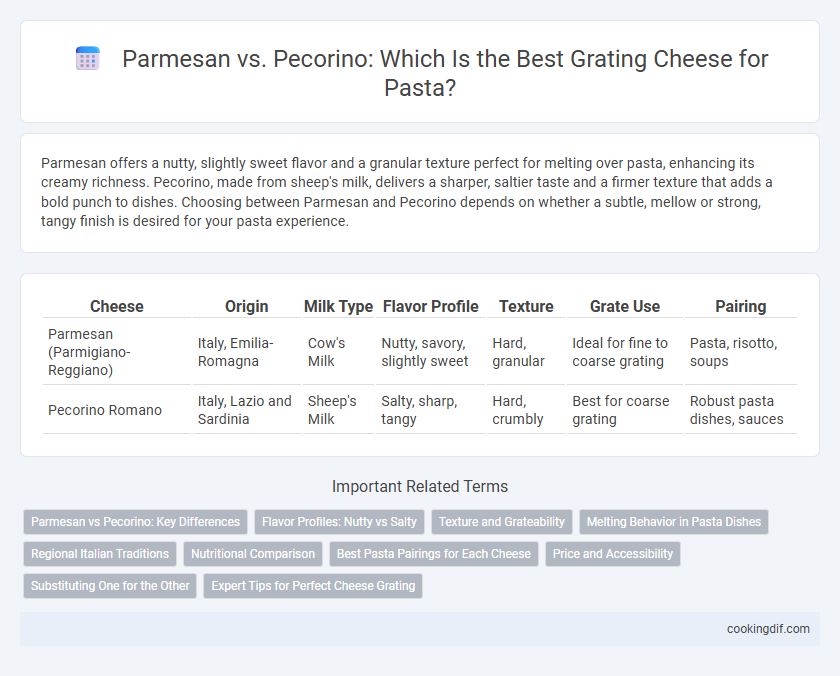Parmesan offers a nutty, slightly sweet flavor and a granular texture perfect for melting over pasta, enhancing its creamy richness. Pecorino, made from sheep's milk, delivers a sharper, saltier taste and a firmer texture that adds a bold punch to dishes. Choosing between Parmesan and Pecorino depends on whether a subtle, mellow or strong, tangy finish is desired for your pasta experience.
Table of Comparison
| Cheese | Origin | Milk Type | Flavor Profile | Texture | Grate Use | Pairing |
|---|---|---|---|---|---|---|
| Parmesan (Parmigiano-Reggiano) | Italy, Emilia-Romagna | Cow's Milk | Nutty, savory, slightly sweet | Hard, granular | Ideal for fine to coarse grating | Pasta, risotto, soups |
| Pecorino Romano | Italy, Lazio and Sardinia | Sheep's Milk | Salty, sharp, tangy | Hard, crumbly | Best for coarse grating | Robust pasta dishes, sauces |
Parmesan vs Pecorino: Key Differences
Parmesan and Pecorino differ significantly in flavor, texture, and origin, with Parmesan (Parmigiano-Reggiano) offering a nutty, savory taste and a granular texture ideal for grating over pasta. Pecorino, made from sheep's milk, delivers a sharper, saltier flavor and a firmer texture, making it perfect for robust dishes needing bold seasoning. Both cheeses vary in aging times, with Parmesan typically aged 12-36 months and Pecorino ranging from 5 to 12 months, which influences their grating suitability and intensity of flavor.
Flavor Profiles: Nutty vs Salty
Parmesan cheese offers a nutty, slightly sweet flavor profile that enhances pasta dishes with a mellow, savory richness. Pecorino cheese, on the other hand, provides a sharper, saltier taste due to its sheep's milk origin, delivering a bold and tangy punch when grated over pasta. Choosing between Parmesan and Pecorino depends on whether you prefer a subtler nuttiness or a more pronounced salty intensity to complement your dish.
Texture and Grateability
Parmesan offers a granular, slightly crumbly texture that grates finely, producing light, fluffy shreds ideal for melting smoothly over pasta. Pecorino, denser and harder, generates coarser, more robust shreds with a sharper bite, building more textured layers atop dishes. The difference in moisture content and aging influences each cheese's grateability, with Parmesan being easier to grate finely while Pecorino demands more effort but yields a bold, hearty finish.
Melting Behavior in Pasta Dishes
Parmesan melts smoothly in pasta dishes, creating a creamy texture that blends seamlessly with sauces, enhancing both flavor and mouthfeel. Pecorino, being a harder and saltier cheese, tends to retain a slightly granular texture when grated and melted, adding a distinct sharpness and bite rather than a creamy melt. The melting behavior of Parmesan makes it ideal for dishes like Alfredo or carbonara, while Pecorino is preferred in recipes where a more robust, textured cheese presence is desired.
Regional Italian Traditions
Parmesan, or Parmigiano-Reggiano, originates from Emilia-Romagna and is prized for its nutty, savory flavor and granular texture ideal for grating over pasta dishes like tagliatelle al ragu. Pecorino Romano, hailing from Lazio and Sardinia, offers a sharper, saltier profile with a harder texture that complements robust pasta recipes such as cacio e pepe. These regional Italian cheese traditions highlight distinct taste profiles that enhance specific pasta varieties, reflecting local ingredients and culinary heritage.
Nutritional Comparison
Parmesan cheese contains approximately 431 calories, 35 grams of protein, and 28 grams of fat per 100 grams, offering a rich source of calcium and vitamin A. Pecorino Romano has a slightly higher caloric density with around 387 calories, 28 grams of protein, and 27 grams of fat per 100 grams, plus notable levels of sodium and vitamin B12. Both cheeses provide beneficial nutrients, but Parmesan tends to have more protein and calcium, while Pecorino is often saltier, influencing its use in pasta dishes.
Best Pasta Pairings for Each Cheese
Parmesan cheese, with its nutty and savory flavor, pairs exceptionally well with creamy pasta dishes like Alfredo, carbonara, and risotto, enhancing their richness without overpowering the ingredients. Pecorino Romano offers a sharper, saltier profile that complements tomato-based sauces such as Cacio e Pepe, Amatriciana, and Arrabbiata, adding a bold tang and depth to the dish. Choosing between Parmesan and Pecorino depends on the pasta sauce's flavor intensity and the desired balance between creaminess and piquancy.
Price and Accessibility
Parmesan cheese generally commands a higher price due to its lengthy aging process and widespread demand, making it moderately accessible in most global markets. Pecorino, often more affordable, varies in availability depending on regional preferences, particularly in Italian and Mediterranean stores. Budget-conscious pasta lovers might favor Pecorino for its cost-effectiveness without sacrificing strong, sharp flavor profiles.
Substituting One for the Other
Parmesan and Pecorino Romano both serve as popular grating cheeses for pasta but differ in flavor and saltiness. Parmesan offers a nutty, slightly sweet taste with a granular texture, making it versatile for most Italian dishes, while Pecorino is sharper, saltier, and made from sheep's milk, which intensifies its flavor. When substituting Pecorino for Parmesan, reduce additional salt in the recipe, and if replacing Pecorino with Parmesan, expect a milder flavor that may benefit from added seasoning to maintain balance.
Expert Tips for Perfect Cheese Grating
For perfect cheese grating, experts recommend using Parmesan when seeking a nutty, mellow flavor that melts smoothly over pasta dishes, while Pecorino offers a sharper, saltier bite ideal for robust sauces. Use a microplane or fine grater for Parmesan to achieve delicate, fluffy shreds that blend effortlessly, whereas a coarser grater highlights Pecorino's crumbly texture and intense aroma. Store both cheeses properly in airtight containers to maintain optimal freshness and flavor during grating.
Parmesan vs Pecorino for grating cheese Infographic

 cookingdif.com
cookingdif.com